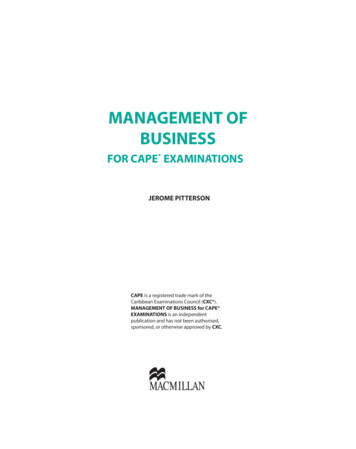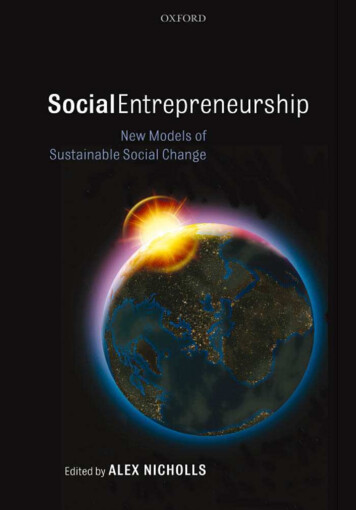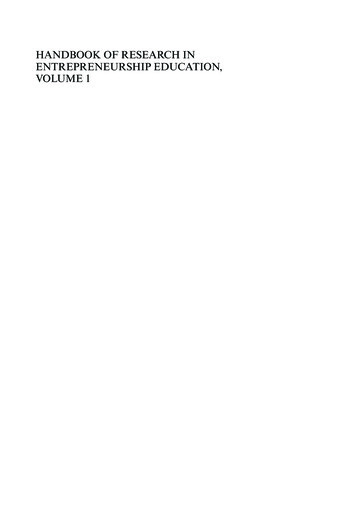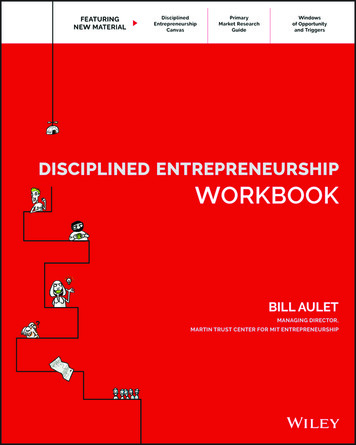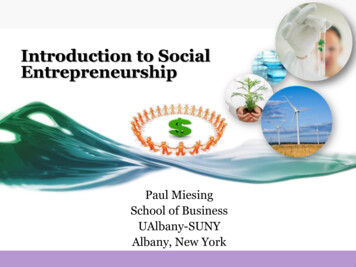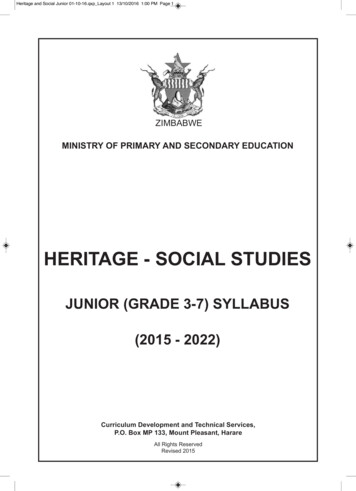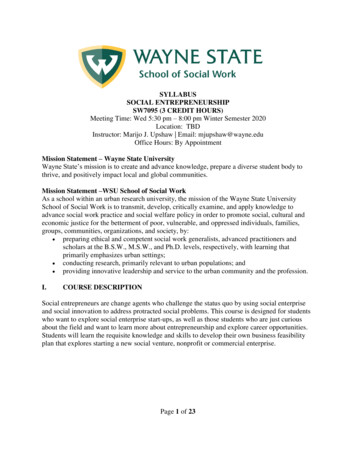
Transcription
SYLLABUSSOCIAL ENTREPRENEURSHIPSW7095 (3 CREDIT HOURS)Meeting Time: Wed 5:30 pm – 8:00 pm Winter Semester 2020Location: TBDInstructor: Marijo J. Upshaw Email: mjupshaw@wayne.eduOffice Hours: By AppointmentMission Statement – Wayne State UniversityWayne State’s mission is to create and advance knowledge, prepare a diverse student body tothrive, and positively impact local and global communities.Mission Statement –WSU School of Social WorkAs a school within an urban research university, the mission of the Wayne State UniversitySchool of Social Work is to transmit, develop, critically examine, and apply knowledge toadvance social work practice and social welfare policy in order to promote social, cultural andeconomic justice for the betterment of poor, vulnerable, and oppressed individuals, families,groups, communities, organizations, and society, by: preparing ethical and competent social work generalists, advanced practitioners andscholars at the B.S.W., M.S.W., and Ph.D. levels, respectively, with learning thatprimarily emphasizes urban settings; conducting research, primarily relevant to urban populations; and providing innovative leadership and service to the urban community and the profession.I.COURSE DESCRIPTIONSocial entrepreneurs are change agents who challenge the status quo by using social enterpriseand social innovation to address protracted social problems. This course is designed for studentswho want to explore social enterprise start-ups, as well as those students who are just curiousabout the field and want to learn more about entrepreneurship and explore career opportunities.Students will learn the requisite knowledge and skills to develop their own business feasibilityplan that explores starting a new social venture, nonprofit or commercial enterprise.Page 1 of 23
Course Objectives: Upon completion of this course, students will be able to: Define social entrepreneurship and distinguish its elements from across a continuum oforganizational structures from traditional nonprofits to social enterprises to traditional forprofits Classify the key elements of, and actors in, the social entrepreneurship ecosystem Engage with a diverse group of social entrepreneurs Assess the strengths and limitations of social entrepreneurship in addressing social problemsin the urban context Appraise the role of the social entrepreneur in addressing protracted social problems,disrupting the status quo and achieving social impact Analyze the operations of a human service organization using social entrepreneurialorientation and industry assessment and diagnostic tools Translate a social problem into an opportunity for co-creation of a social value by applyingsocial enterprise and social innovation research and models Apply the Social Business Model Canvas and lean startup methods for planning, developing,testing, launching and evaluating social change ventures Analyze different business models for social change ventures Compare funding options for social change ventures Recommend the best entity structure for their proposed social change venture Construct a business feasibility plan that addresses root causes of social problems, leveragesefforts to produce maximum change, lowers barriers for users of services, engages andcommunities in solving their own problems, and builds a sustainable business model Critique the feasibility of implementing the proposed business plan Evaluate options for careers across the social entrepreneurship continuum includingdeveloping their own social enterprise or enterprising nonprofit startup, as well as acting asan intrapreneur in existing organizations across private and public sectorsII.COURSE COMPETENCIES AND PRACTICE BEHAVIORS FOR THISCOURSECOMPETENCIES1. Demonstrate Ethical and Professional Behavior Evaluate options for careers across the social entrepreneurship continuum includingdeveloping their own social enterprise or enterprising nonprofit startup, as well as actingas an intrapreneur in existing organizations across private and public sectors2. Engage diversity and difference in practice Engage with a diverse group of social entrepreneurs3. Advance Human Rights and Social, Economic, and Environmental Justice Construct a business feasibility plan that addresses root causes of social problems,leverages efforts to produce maximum change, lowers barriers for users of services,Page 2 of 23
engages and communities in solving their own problems, and builds a sustainablebusiness model4. Engage in Practice-informed Research and Research-informed Practice Define social entrepreneurship and distinguish its elements from across a continuum oforganizational structures from traditional nonprofits to social enterprises to traditionalfor-profits Classify the key elements of, and actors in, the social entrepreneurship ecosystem Appraise the role of the social entrepreneur in addressing protracted social problems,disrupting the status quo and achieving social impact Translate a social problem into an opportunity for co-creation of a social value byapplying social enterprise and social innovation research and models Apply the Social Business Model Canvas and lean startup methods for planning,developing, testing, launching and evaluating social change ventures7. Assess Individuals, Families, Groups, Organizations, and Communities Analyze the operations of a human service organization using social entrepreneurialorientation and industry assessment and diagnostic tools Translate a social problem into an opportunity for co-creation of a social value byapplying social enterprise and social innovation research and models Apply the Social Business Model Canvas and lean startup methods for planning,developing, testing, launching and evaluating social change ventures Analyze different business models for social change ventures Compare funding options for social change ventures Recommend the best entity structure for their proposed social change venture9. Evaluate Practice with Individuals, Families, Groups, Organizations, andCommunities Critique the feasibility of implementing the proposed business plan Evaluate options for careers across the social entrepreneurship continuum includingdeveloping their own social enterprise or enterprising nonprofit startup, as well as actingas an intrapreneur in existing organizations across private and public sectors10. Analyze impact of urban context on a range of client systems, including practiceimplications5. Assess the strengths and limitations of social entrepreneurship in addressing socialproblems in the urban contextPage 3 of 23
III.TEXTS AND REQUIRED MATERIALRequired:Chahine, T. (2016). Introduction to social entrepreneurship. Boca Raton, FL: CRC Press.Guo, C., & Bielefeld, W. (2014). Social entrepreneurship: An evidence-based approach tocreating social value. San Francisco, CA: Jossey-Bass.WSU eBook, http://elibrary.wayne.edu/record b4810879 S47Janus, K. K. (2017). Social startup success. New York, NY: Lifelong Books.IV.PERFORMANCE CRITERIAThe extent of each student’s achievement of knowledge and skill objectives will be evaluatedusing written assignments, reports and papers, as well as in-class presentations and participation.The performance criteria for course assignments will be discussed in class and outlined in agrading rubric for each assignment.Grading includes:a) Technical Format: Soundness of technical writing, professional appearance, appropriate use ofreferences (APA), adherence to the prescribed format for submission of each assignment,appropriate use of grammar and punctuation, and the absence of typographical and spellingerrors. Papers must be well written and carefully presented to receive a grade in the A range.b) Substantive Content: Full and adequate response to each of the required sections and adequacyand unity of argument and presentation.c) Terminology and Concepts: Adequate, full and appropriate use of program and resourcedevelopment knowledge, terminology and concepts, and command of material conveys amessage that the terms and concepts are fully understood.d) Preparation and participation are an integral part of each class. Students can earn 50 points forreading the weekly required readings and reflecting on them before the class meets that week.The following are also included in participation:-You attend class each session.-You arrive to class on-time and prepared to discuss the assigned readings.-You remain for the entire class, unless prior acceptable arrangements have been made with theinstructor.-You are engaged and attentive throughout the class period.-You respond to questions and actively participate in class discussions.Page 4 of 23
-You participate in all presentationsV.GRADING AND ASSIGNMENTSINDIVIDUAL ASSIGNMENTSSocial Entrepreneurship Ecosystem – Conductan online assessment of an assigned organizationin the social entrepreneurship ecosystem.Deliver an IGNITE presentation.Turn in a brief written report.DUE01/30/2019POINTSCOMPETENCIES251, 2, 3, 4, 750Elevator Pitch for a Social Venture – Present a1-minute pitch to class for a social venture02/13/2019concept idea that addresses a social problem andyour proposed solution to the problemCharacterizing a Social Problem – Turn a briefwritten report of your social venture conceptidea characterizing a social problem and yourproposed solution to the problemRequired Reading Reflections – Completeweekly reading reflections. (See Canvas forWeeklydetails on weekly reflection questions and exactdue dates)10Classroom & Group ParticipationGROUP ASSIGNMENTSBusiness Feasibility Plan – The benchmarkassignment for this course is to develop abusiness feasibility plan for a social changeventure due in the following review assignments.Teams will be formed from the best pitch ideas.Concept Idea & Literature ReviewStakeholder AnalysisIndustry AnalysisMarket StrategyCompetitive Landscape TableSocial Business CanvasPESTEL AnalysisLogic Model501, 2POINTS 15151015Pitch Deck Presentation04/17/201925Final Business Feasibility Plan Proposal04/21/2019175DUE1, 2, 3, 4, 715501, 2, 3, 4, 7, 9, 101, 2, 3, 4, 7, 9, 10Page 5 of 23
Total Points500Weighted scaleWeighted Scale45% Individual Assignments45% Final Proposal & Presentation10% Review AssignmentsGrading Policy:Since this is master’s level course, students may pass the course with a grade of C, but MSWstudents must maintain a B average. (See graduate Bulletin, Wayne State t/index.html)GRADING SCALEVI.GRADECUMULATIVE POINTSAAB EC CFCUMULATIVE POINTS385-399.9365-384.9BELOW 365INTRODUCTION AND ORGANIZATION OF THE COURSESocial entrepreneurship is a broad interdisciplinary field that encompasses aspects of socialenterprise and social innovation, and mixed methods to achieve social change. This is an electivecourse designed to help students who are interested in exploring the field of socialentrepreneurship, and how it fits with their career aspirations including starting new ventures orworking in human service settings where business and entrepreneurship knowledge, skills anduse of self are needed. Students will learn about the history of social entrepreneurship. Studentswill study and analyze domestic and global applications of social entrepreneurship theories,concepts and practices. Students will gain knowledge and acquire skills in utilizing business andfinancial measures, reports and tools that can be broadly applied in their careers as changeagents. As a benchmark assignment, students will identify a social problem or unmet need in thecommunity or around the globe and construct a business feasibility plan that examines theviability of developing a start-up social or commercial enterprise, a program within an existingnonprofit organization, or a collaborative venture that addresses the need.This course is taught using lecture, class discussion, in-class exercises, videos, guest speakersand graded assignments.Page 6 of 23
VII.ROLE OF THE STUDENT AND INSTRUCTORSee University Statement of Obligation of Students and Faculty Members of the teaching learning process http://www.bulletins.wayne.edu/fib/fib2d.html.This course is a partnership between the instructor and the students. With such an arrangementcome responsibilities of both parties. The general expectations are identified as follows:The instructor will adhere to the Wayne State University standards for teacher responsibilities.For further details, please refer to the University Statement of Obligation of Students and FacultyMembers within the teaching-learning process, in the WSU Bulletin, as above.Preparation: It is expected that the student come to each class session well-prepared to discussthe scheduled topics. It is expected that the students will complete each reading assignment andbe sufficiently prepared to apply the readings in class.Class participation: This may include raising questions from the readings/discussion, makingrelevant comments, reacting to opinions expressed by the instructor or fellow students, in classwriting activities, asking for clarification, engaging in class exercises, and bringing up issues ofgeneral interest to the class.VIII. POLICIES FOR THIS COURSEAttendance: It is expected that students attend each class session. If the instructor is unable toattend a session due to an illness or emergency, efforts will be made to contact the students priorto the class session. In the event a student is unable to attend a session due to illness, emergencyor special circumstance, the student is to notify the instructor prior to the session that student willbe missing. Each class session will start promptly at its scheduled time. Students should be ontime and plan to attend the entire class session. If a student must leave early for someunpreventable reason, the student should inform the instructor prior to the start of the class.Unless there are serious extenuating circumstances, a student will not be able to earn an A for thecourse with more than two absences, a B with more than four absences, or a C with more thansix absences.Incivility and disruptive behavior are not acceptable and may result in a request to leave classand referral to the appropriate university office. Some examples of inappropriate classroomconduct include arriving late to class, leaving class early, using a cellular telephone in theclassroom, texting during class, surfing the web during class, interrupting others who have beengiven permission to speak, carrying on side conversations while others are speaking, sleepingduring class, interrupting class to discuss an unrelated issue, and being disrespectful (verbally ornonverbally) toward classmates or the instructor. This list is obviously not exhaustive.Use of cell phones is prohibited; if you are expecting a call due to an unforeseen emergencynotify the instructor at the beginning of class. The use of laptop computers, iPads or handhelddevices in class for taking notes or following PowerPoint presentations is allowed. The use ofPage 7 of 23
laptops, phones or other devices during class for checking e-mail, sending text messages, surfingthe web, blogging, tweeting, or other activities not related to class is prohibited.Assignments: The instructor will provide clear and timely descriptions, directions and gradingcriteria for assignments. Furthermore, the instructor will review, grade and return theassignments back to the students within a reasonable and defined time frame. It is expected thatthe student will turn in assignments when they are due, using the Canvas submission process orat the beginning of class as requested by the instructor. Specified assignments must be in APAformat with appropriate citations. Plagiarism will not be tolerated and will be addressed inaccordance with university policy.Late Policy for Assignments: All assignments are due at the specified date and time. Thispolicy is used in fairness to all those who turn in assignments on time and is also consistent withgood professional practice. Late assignments will receive reduced points. Late assignments willautomatically be reduced by 10% of the total available points for the assignment. For eachadditional 5 days an assignment is late, an additional 10% will be deducted from your grade onthe assignment. However, I have a “life happens” policy that allows students with a legitimatereason to request one assignment to be turned in late up to 5 days. Beyond this one exception, Iwill not grant late assignments for any reason. I encourage students to refrain from taking the lateassignment exemption unless needed.“Incomplete” grades will be given in accordance with WSU SSW policy, which can be found athttp://socialwork.wayne.edu/incomplete grade policy.pdf Please note these important pointsfrom that policy: to receive an Incomplete, a student must be passing a course; an Incompleterequires a written plan for completion, using the SSW form, which also requires the signature ofthe student’s advisor; the Incomplete must be mutually agreed upon in advance, before gradesare submitted; and any Incomplete grade must be changed to a letter grade before the beginningof the next semester. It is also important to note that a grade of Incomplete may affect astudent’s financial aid.Incivility and disruptive behavior is not acceptable and may result in a request to leave classand referral to the appropriate university office. Some examples of inappropriate classroomconduct include arriving late to class, leaving class early, using a cellular telephone in theclassroom, texting during class, surfing the web during class, interrupting others who have beengiven permission to speak, carrying on side conversations while others are speaking, sleepingduring class, interrupting class to discuss an unrelated issue, and being disrespectful (verbally ornonverbally) toward classmates or the instructor. This list is obviously not exhaustive.Religious holidays (from the online Academic Calendar): Because of the extraordinary varietyof religious affiliations of the University student body and staff, the Academic Calendar makesno provisions for religious holidays. However, it is University policy to respect the faith andreligious obligations of the individual. Students with classes or examinations that conflict withtheir religious observances are expected to notify their instructors well in advance so thatmutually agreeable alternatives may be worked out.Page 8 of 23
Student Disabilities Services: If you have a documented disability that requiresaccommodations, you will need to register with Student Disability Services for coordination ofyour academic accommodations. The Student Disability Services (SDS) office is located at 1600David Adamany Undergraduate Library in the Student Academic Success Services department.The SDS telephone number is 313-577-1851 or 313-202-4216 forvideophone use. Once you have your accommodations in place, I will be glad to meet with youprivately during my office hours to discuss your special needs. Student Disability Services’mission is to assist the university in creating an accessible community where students withdisabilities have an equal opportunity to fully participate in their educational experience atWayne State University. You can learn more about the disability office atwww.studentdisability.wayne.eduTo register with Student Disability Services, complete the online registration form at:https://wayne-accommodate.symplicity.com/public accommodation/Counseling and Psychological Services (CAPS): It is quite common for college students toexperience mental health challenges, such as stress, anxiety and depression, that interfere withacademic performance and negatively impact daily life. Help is available for any currentlyenrolled WSU student
Mission Statement – Wayne State University Wayne State’s mission is to create and advance knowledge, prepare a diverse student body to thrive, and positively impact local and global communities. Mission Statement –WSU School of Social Work As a school within an urban research university, t
